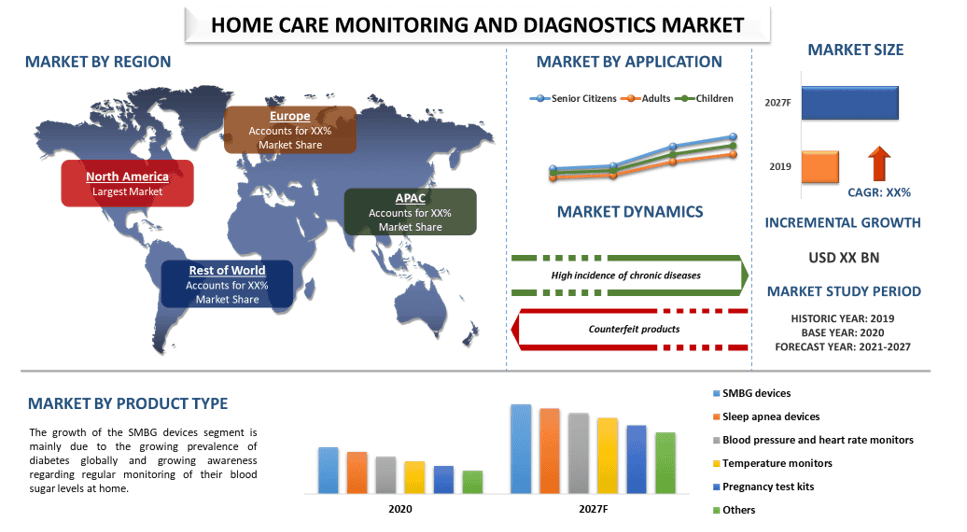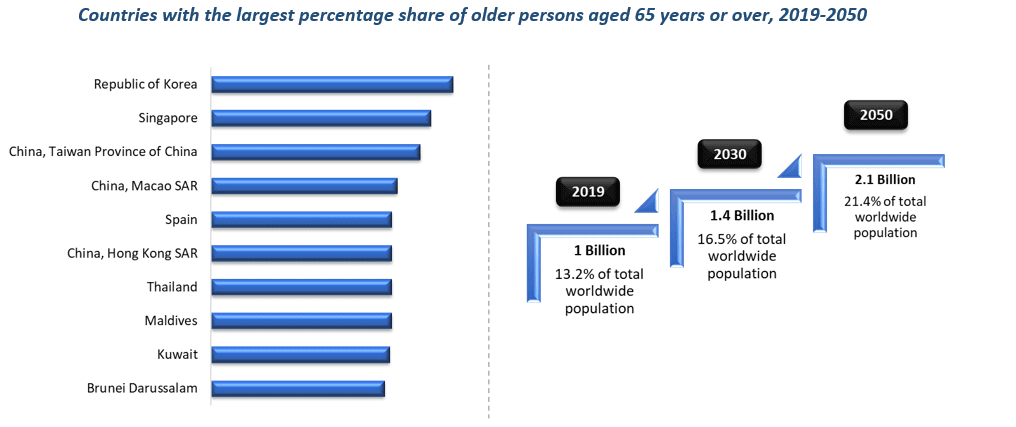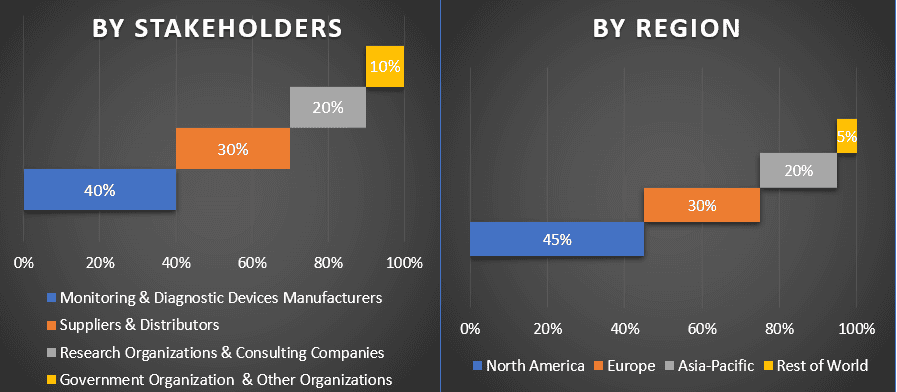- Home
- About Us
- Industry
- Services
- Reading
- Contact Us
Home Care Monitoring And Diagnostics Market: Current Analysis and Forecast (2021-2027)
Emphasis on Product Type (SMBG Devices, Sleep Apnea Devices, Blood Pressure & Heart Rate Monitors, Temperature Monitors, Pregnancy Test Kits, Others); Application (Children, Adults, Old); Region/Country

Global Home Care Monitoring And Diagnostics Market is anticipated to grow with an elevated CAGR of around 9% over the forecast period (2021-2027). Home care monitoring and diagnostics devices include a wide variety of various healthcare products like heart rate monitors, blood glucose monitors, and others. these devices are portable, user-friendly, and allow patients to keep regular track of their health at the comfort of their homes.
With the rapid advancement in technology and rising awareness among the target population regarding the at-home monitoring solutions, many industry players are focusing on expanding their portfolio by launching new services and products in the market due to which the home care monitoring and diagnostics market is witnessing an uptick all over the globe. For example, in June 2021, Max Healthcare, one of the largest healthcare providers in India launched an artificial intelligence (AI) powered device integrated patient monitoring framework in collaboration with digital health solutions provider MyHealthcare. Patients can use the platform Max MyHealth to monitor their vitals with clinical devices integrated to the app, allowing clinical readings to flow seamlessly from the device into the app and into the electronic medical records (EMR), for the doctor’s review. Furthermore, the demand for home care monitoring and diagnostics is increasing on account of the growth in the aging population coupled with the rising prevalence of numerous chronic diseases across the globe.

Abbott Laboratories, Bioptik Technology Inc., F. Hoffmann-La Roche Ltd., Medtronic Plc, Johnson & Johnson, Philips Healthcare, Omron Healthcare, Fitbit, Chongqing Haray International Business, VectraCor Inc., are some of the prominent players operating in the home care monitoring and diagnostics market. Several M&As along with partnerships have been undertaken by these players to facilitate customers with new varieties of home care monitoring and diagnostics devices.
Insights Presented in the Report
“Amongst Product Type, SMBG devices segment holds the major share”
Based on product type, the home care monitoring and diagnostics market is segmented into SMBG devices, sleep apnea devices, blood pressure & heart rate monitors, temperature monitors, pregnancy test kits, and others. The SMBG devices segment accounted for a significant market share in 2020 and it is estimated that it will exhibit the highest CAGR during the forecast period. The growth of this segment is mainly due to the increasing number of diabetic patients globally. Furthermore, the demand for self-monitoring blood glucose devices is on the rise owing to the growing awareness regarding home monitoring of their blood sugar levels and the focus on regular diabetes management among patients to reduce the risk of hyperglycemic conditions.
“Amongst Application, senior citizen segment holds the major share”
Based on application, the home care monitoring and diagnostics market is divided into children, adults, and senior citizens. The old segment grabbed a significant market share in 2020 and is anticipated to grow at a rapid rate in the upcoming years owing to the rapidly increasing geriatric population and rising prevalence of various chronic diseases among them. For instance, as per the WHO, between 2015 and 2050, the proportion of the world’s population over 60 years will nearly double from 12% to 22%. Also, 1 in 6 people in the world will be aged 60 years or over by 2030.
“North America represents one of the largest markets of home care monitoring and diagnostics market”
For a better understanding of the market dynamics of the home care monitoring and diagnostics market, a detailed analysis was conducted for different regions across the globe including North America (U.S, Canada, and the Rest of North America), Europe (Germany, France, Spain, United Kingdom, Italy, and Rest of Europe), Asia-Pacific (China, India, Australia, Japan, and Rest of APAC), Rest of World has been conducted. In 2020, North America dominated the home care monitoring and diagnostics industry. This can be mainly due to the presence of well-established market players and frequent product launches in the region.
Reasons to buy this report:
- The study includes market sizing and forecasting analysis validated by authenticated key industry experts
- The report presents a quick review of overall industry performance at one glance
- The report covers an in-depth analysis of prominent industry peers with a primary focus on key business financials, product portfolio, expansion strategies, and recent developments
- Detailed examination of drivers, restraints, key trends, and opportunities prevailing in the industry
- The study comprehensively covers the market across different segments
- Deep dive regional level analysis of the industry
Customization Options:
The global home care monitoring and diagnostics market can further be customized as per the requirement or any other market segment. Besides this, UMI understands that you may have your own business needs, hence feel free to connect with us to get a report that completely suits your requirements.
Table of Content
Research Methodology for the Global Home Care Monitoring And Diagnostics Market Analysis (2021-2027)
Analyzing the historical market, estimation of the current market, and forecasting the future market of the global home care monitoring and diagnostics market were the three major steps undertaken to create and analyze the adoption of home care monitoring and diagnostics in major regions globally. Exhaustive secondary research was conducted to collect the historical market numbers and estimate the current market size. Secondly, to validate these insights, numerous findings and assumptions were taken into consideration. Moreover, exhaustive primary interviews were also conducted, with industry experts across the value chain of the global home care monitoring and diagnostics market. Post assumption and validation of market numbers through primary interviews, we employed a top-down/bottom-up approach to forecasting the complete market size. Thereafter, market breakdown and data triangulation methods were adopted to estimate and analyze the market size of segments and sub-segments the industry pertains to. Detailed methodology is explained below:
Seek More Details About Research Methodology
Analysis of Historical Market Size
Step 1: In-Depth Study of Secondary Sources:
Detail secondary study was conducted to obtain the historical market size of the home care monitoring and diagnostics through company internal sources such as annual report & financial statements, performance presentations, press releases, etc., and external sources including journals, news & articles, government publications, competitor publications, sector reports, third-party database, and other credible publications.
Step 2: Market Segmentation:
After obtaining the historical market size of the home care monitoring and diagnostics market, we conducted a detailed secondary analysis to gather historical market insights and share for different segments & sub-segments for major regions. Major segments included in the report as product type and application. Further country-level analyses were conducted to evaluate the overall adoption of home care monitoring and diagnostics across the globe.
Step 3: Factor Analysis:
After acquiring the historical market size of different segments and sub-segments, we conducted a detailed factor analysis to estimate the current market size of the home care monitoring and diagnostics. Further, we conducted factor analysis using dependent and independent variables such as the growing number of people with chronic diseases and the increasing elderly population all over the globe. A thorough analysis was conducted for demand and supply-side scenarios considering top partnerships, merger and acquisition, business expansion, and product launches in the home care monitoring and diagnostics sector across the globe.
Current Market Size Estimate & Forecast
Current Market Sizing: Based on actionable insights from the above 3 steps, we arrived at the current market size, key players in the home care monitoring and diagnostics market, and market shares of the segments. All the required percentage shares split, and market breakdowns were determined using the above-mentioned secondary approach and were verified through primary interviews.
Estimation & Forecasting: For market estimation and forecast, weights were assigned to different factors including drivers & trends, restraints, and opportunities available for the stakeholders. After analyzing these factors, relevant forecasting techniques i.e., top-down/bottom-up approach was applied to arrive at the market forecast about 2027 for different segments and subsegments across the major markets globally. The research methodology adopted to estimate the market size encompasses:
- The industry’s market size, in terms of value (US$) and the adoption rate of home care monitoring and diagnostics across the major markets domestically
- All percentage shares, splits, and breakdowns of market segments and sub-segments
- Key players in the home care monitoring and diagnostics market in terms of products offered. Also, the growth strategies adopted by these players to compete in the fast-growing market
Market Size and Share Validation
Primary Research: In-depth interviews were conducted with the Key Opinion Leaders (KOLs) including Top Level Executives (CXO/VPs, Sales Head, Marketing Head, Operational Head, and Regional Head, Country Head, etc.) across major regions. Primary research findings were then summarized, and statistical analysis was performed to prove the stated hypothesis. Inputs from primary research were consolidated with secondary findings, hence turning information into actionable insights.
Split of Primary Participants in Different Regions

Market Engineering
Data triangulation technique was employed to complete the overall market estimation and to arrive at precise statistical numbers of each segment and sub-segment of the home care monitoring and diagnostics market. Data was split into several segments & sub-segments post studying various parameters and trends in the areas of product type and application of the home care monitoring and diagnostics market.
The main objective of the Home Care Monitoring And Diagnostics Market Study
The current & future market trends of home care monitoring and diagnostics were pinpointed in the study. Investors can gain strategic insights to base their discretion for investments on the qualitative and quantitative analysis performed in the study. Current and future market trends determined the overall attractiveness of the market at a regional level, providing a platform for the industrial participant to exploit the untapped market to benefit as a first-mover advantage. Other quantitative goals of the studies include:
- Analyze the current and forecast market size of home care monitoring and diagnostics in terms of value (US$). Also, analyze the current and forecast market size of different segments and sub-segments
- Segments in the study include areas of product type and application
- Define and analysis of the regulatory framework for the home care monitoring and diagnostics industry
- Analyze the value chain involved with the presence of various intermediaries, along with analyzing customer and competitor behaviors of the industry
- Analyze the current and forecast market size of the home care monitoring and diagnostics market for the major region
- Major regions studied in the report include North America, Europe, Asia-Pacific and Rest of the world
- Company profiles of the home care monitoring and diagnostics market and the growth strategies adopted by the market players to sustain in the fast-growing market
- Deep dive regional level analysis of the industry
Related Reports
Customers who bought this item also bought










